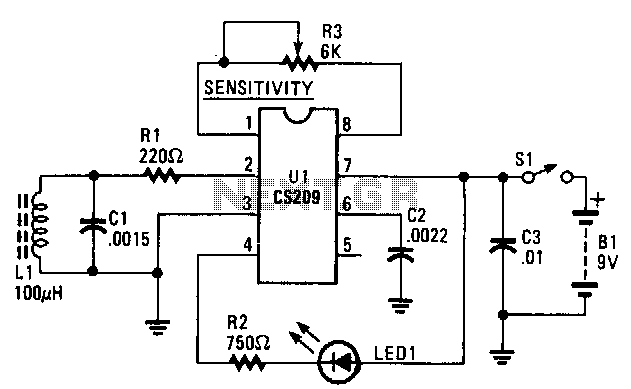
Stud-finder

The CS209 is designed to detect the presence or proximity of magnetic metals. It has an internal oscillator that, along with its external LC resonant circuit, provides oscillations whose amplitude is dependent upon the Q of the LC network. Close proximity to magnetic material reduces the Q of the tuned circuit, thus the oscillations tend to decrease in amplitude. The decrease in amplitude is detected and used to turn on LED1, indicating the presence of a magnetic material (i.e., nail or screw).
The CS209 circuit operates on the principle of inductive sensing, utilizing an internal oscillator to generate a frequency signal. This oscillator is coupled with an external LC (inductor-capacitor) resonant circuit, which is finely tuned to a specific frequency. The quality factor (Q) of the LC circuit is a crucial parameter, as it determines the sharpness of the resonance peak and the amplitude of the oscillations produced.
When magnetic materials such as iron or steel come into proximity with the sensor, they affect the magnetic field around the inductor, leading to a decrease in the Q factor of the resonant circuit. This reduction in Q results in a notable decrease in the amplitude of the oscillations. The CS209 is equipped with a detection mechanism that continuously monitors the amplitude of these oscillations.
When the amplitude falls below a predetermined threshold, the circuit activates an output signal that turns on LED1. This visual indicator serves as a straightforward means of confirming the presence of magnetic materials, such as nails or screws, making the CS209 suitable for applications in metal detection, security systems, and other fields where identifying ferromagnetic objects is essential.
The design of the circuit may include additional components such as resistors for biasing, capacitors for filtering, and possibly a microcontroller for enhanced functionality, allowing for adjustable sensitivity or additional output options. Overall, the CS209 provides a reliable and efficient solution for magnetic metal detection through its well-engineered oscillator and resonant circuit configuration.The CS209 is designed to detect the presence or proximity ofmagnetic metals. It has an internal oscillator that, along with its external lc resonant circuit, provides oscillations whose amplitude is dependent upon the Q of the lc network. Close proximity to magnetic material reduces the Q of the tuned circuit, thus the oscillations tend to decrease in amplitude.
The decrease in amplitude is detected and used in turn on LEDl, indicating the presence of a magnetic material (i.e., nail or screw). 🔗 External reference
The CS209 circuit operates on the principle of inductive sensing, utilizing an internal oscillator to generate a frequency signal. This oscillator is coupled with an external LC (inductor-capacitor) resonant circuit, which is finely tuned to a specific frequency. The quality factor (Q) of the LC circuit is a crucial parameter, as it determines the sharpness of the resonance peak and the amplitude of the oscillations produced.
When magnetic materials such as iron or steel come into proximity with the sensor, they affect the magnetic field around the inductor, leading to a decrease in the Q factor of the resonant circuit. This reduction in Q results in a notable decrease in the amplitude of the oscillations. The CS209 is equipped with a detection mechanism that continuously monitors the amplitude of these oscillations.
When the amplitude falls below a predetermined threshold, the circuit activates an output signal that turns on LED1. This visual indicator serves as a straightforward means of confirming the presence of magnetic materials, such as nails or screws, making the CS209 suitable for applications in metal detection, security systems, and other fields where identifying ferromagnetic objects is essential.
The design of the circuit may include additional components such as resistors for biasing, capacitors for filtering, and possibly a microcontroller for enhanced functionality, allowing for adjustable sensitivity or additional output options. Overall, the CS209 provides a reliable and efficient solution for magnetic metal detection through its well-engineered oscillator and resonant circuit configuration.The CS209 is designed to detect the presence or proximity ofmagnetic metals. It has an internal oscillator that, along with its external lc resonant circuit, provides oscillations whose amplitude is dependent upon the Q of the lc network. Close proximity to magnetic material reduces the Q of the tuned circuit, thus the oscillations tend to decrease in amplitude.
The decrease in amplitude is detected and used in turn on LEDl, indicating the presence of a magnetic material (i.e., nail or screw). 🔗 External reference